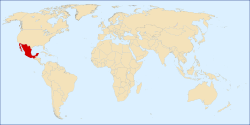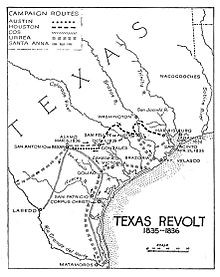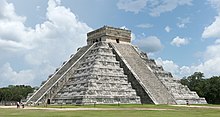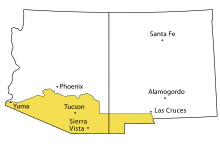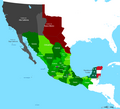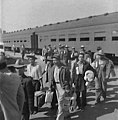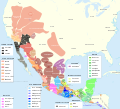|
The Temple of Warriors at Chichen Itza, Mexico
¡Bienvenido! Welcome to the Mexico portal
Mexico, officially the United Mexican States, is a country in the southern portion of North America. It covers 1,972,550 km2 (761,610 sq mi), making it the world's 13th-largest country by area; with a population of almost 130 million, it is the 10th-most-populous country and the most populous Spanish-speaking country. Mexico is organized as a federal constitutional republic comprising 31 states and Mexico City, its capital. It shares land borders with the United States to the north, with Guatemala and Belize to the southeast; as well as maritime borders with the Pacific Ocean to the west, the Caribbean Sea to the southeast, and the Gulf of Mexico to the east.
This is a Featured article, which represents some of the best content on English Wikipedia.
The Texas Revolution (October 2, 1835 – April 21, 1836) was a rebellion of colonists from the United States and Tejanos (Hispanic Texans) against the centralist government of Mexico in the Mexican state of Coahuila y Tejas. Although the uprising was part of a larger one, the Mexican Federalist War, that included other provinces opposed to the regime of President Antonio López de Santa Anna, the Mexican government believed the United States had instigated the Texas insurrection with the goal of annexation. The Mexican Congress passed the Tornel Decree, declaring that any foreigners fighting against Mexican troops "will be deemed pirates and dealt with as such, being citizens of no nation presently at war with the Republic and fighting under no recognized flag". Only the province of Texas succeeded in breaking with Mexico, establishing the Republic of Texas. It was eventually annexed by the United States. The revolution began in October 1835, after a decade of political and cultural clashes between the Mexican government and the increasingly large population of Anglo-American settlers in Texas. The Mexican government had become increasingly centralized and the rights of its citizens had become increasingly curtailed, particularly regarding immigration from the United States. Mexico had officially abolished slavery in Texas in 1829, and the desire of Anglo Texans to maintain the institution of chattel slavery in Texas was also a major cause of secession. Colonists and Tejanos disagreed on whether the ultimate goal was independence or a return to the Mexican Constitution of 1824. While delegates at the Consultation (provisional government) debated the war's motives, Texians and a flood of volunteers from the United States defeated the small garrisons of Mexican soldiers by mid-December 1835. The Consultation declined to declare independence and installed an interim government, whose infighting led to political paralysis and a dearth of effective governance in Texas. An ill-conceived proposal to invade Matamoros siphoned much-needed volunteers and provisions from the fledgling Texian Army. In March 1836, a second political convention declared independence and appointed leadership for the new Republic of Texas. (Full article...)Selected article -Chichén Itzá (often spelled Chichen Itza in English and traditional Yucatec Maya) was a large pre-Columbian city built by the Maya people of the Terminal Classic period. The archeological site is located in Tinúm Municipality, Yucatán State, Mexico. Chichén Itzá was a major focal point in the Northern Maya Lowlands from the Late Classic (c. AD 600–900) through the Terminal Classic (c. AD 800–900) and into the early portion of the Postclassic period (c. AD 900–1200). The site exhibits a multitude of architectural styles, reminiscent of styles seen in central Mexico and of the Puuc and Chenes styles of the Northern Maya lowlands. The presence of central Mexican styles was once thought to have been representative of direct migration or even conquest from central Mexico, but most contemporary interpretations view the presence of these non-Maya styles more as the result of cultural diffusion. (Full article...)Selected picture An animated image showing the territorial evolution of Mexico, showing each change to the internal and external borders of the country. The animation begins with the 1824 Constitution of Mexico and continues to the present-day configuration. Note that many of the borders of states and territories in northern Mexico remain unclear and minor border adjustments with the United States, including the several Rio Grande border disputes, are not shown. image credit: Golbez
This is a Good article, an article that meets a core set of high editorial standards.
The Gadsden Purchase (Spanish: Venta de La Mesilla "La Mesilla sale") is a 29,640-square-mile (76,800 km2) region of present-day southern Arizona and southwestern New Mexico that the United States acquired from Mexico by the Treaty of Mesilla, which took effect on June 8, 1854. The purchase included lands south of the Gila River and west of the Rio Grande where the U.S. wanted to build a transcontinental railroad along a deep southern route, which the Southern Pacific Railroad later completed in 1881–1883. The purchase also aimed to resolve other border issues. The first draft was signed on December 30, 1853, by James Gadsden, U.S. minister to Mexico, and by Antonio López de Santa Anna, president of Mexico. The U.S. Senate voted in favor of ratifying it with amendments on April 25, 1854, and then sent it to President Franklin Pierce. Mexico's government and its General Congress or Congress of the Union took final approval action on June 8, 1854, when the treaty took effect. The purchase was the last substantial territorial acquisition in the contiguous United States, and defined the Mexico–United States border. The Arizona cities of Tucson, Yuma and Tombstone are on territory acquired by the U.S. in the Gadsden Purchase. (Full article...)Selected biography -Benito Pablo Juárez García (Spanish: [beˈnito ˈpaβlo ˈxwaɾes ɣaɾˈsi.a] ⓘ; 21 March 1806 – 18 July 1872) was a Mexican Liberal lawyer and statesman who served as the 26th president of Mexico from 1858 until his death in office in 1872. Of Zapotec ancestry, he was the first and only indigenous president of Mexico and the first democratically elected indigenous president in the postcolonial Americas. Previously, he had served as Governor of Oaxaca and had later ascended to a variety of federal posts including Secretary of the Interior, Secretary of Public Education, and President of the Supreme Court. During his presidency he led the Liberals to victory in the Reform War and in the Second French intervention in Mexico. Born in Oaxaca to a poor, rural, Indigenous family and orphaned as a child, Juárez passed under the care of his uncle, eventually moving to Oaxaca City at the age of 12, where he found work as a domestic servant. Sponsored by his employer who was also a lay Franciscan, Juárez temporarily enrolled in a seminary and studied to become a priest, but he later switched his studies to law at the Institute of Sciences and Arts, where he became active in Liberal politics. He began to practice law and was eventually appointed as a judge, after which he married Margarita Maza, a woman from a socially distinguished family in Oaxaca City. (Full article...)
In the news
Selected fare or cuisine -A burrito (English: /bəˈriːtoʊ/, Spanish: [buˈrito] ⓘ) in Mexico is, historically, a regional name, among others, for what is known as a taco, a tortilla filled with food, in other parts of the country. In modern times, it is considered by many as a different dish in Mexican and Tex-Mex cuisine that took form in Ciudad Juárez, consisting of a flour tortilla wrapped into a sealed cylindrical shape around various ingredients. The tortilla is sometimes lightly grilled or steamed to soften it, make it more pliable, and allow it to adhere to itself. Burritos are often eaten by hand, as their tight wrapping keeps the ingredients together. Burritos can also be served "wet", i.e., covered in a savory and spicy sauce, when they would be eaten with a fork and knife. Burritos are filled with savory ingredients, most often a meat such as beef, chicken, or pork, and often include other ingredients, such as rice, cooked beans (either whole or refried), vegetables, such as lettuce and tomatoes, cheese, and condiments such as salsa, pico de gallo, guacamole, or crema. (Full article...)
General imagesThe following are images from various Mexico-related articles on Wikipedia.
CategoriesTopicsRelated portalsWikiProjectYou are invited to participate in WikiProject Mexico, a WikiProject dedicated to developing and improving articles about Mexico. Associated WikimediaMore portals | ||||||||||



